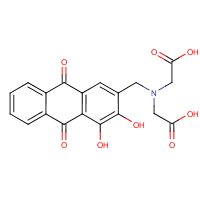Alizarin complexone
Agent Name
Alizarin complexone
CAS Number
3952-78-1
Formula
C19-H15-N-O8
Major Category
Dyes

Synonyms
(((3,4-Dihydroxy-2-anthraquinonyl)methyl)imino)diacetic; acid dihydrate; 1,2-Dihydroxy-anthrachinon-3-methylen-iminodiessigsaeure; [German]; 3-Aminomethylalizarin-N,N-diacetic acid; Acetic acid, (((3,4-dihydroxy-2-anthraquinonyl)methyl)imino)di-; Alizarin Fluorine Blue; Alizarin complexon; Alizarin complexone; Alizarine Fluorine Blue; Alizarine complexon; Alizarine complexone; Alizarinkomplexon; Glycine, N-(carboxymethyl)-N-((9,10-dihydro-3,4-dihydroxy-9,10-dioxo-2-anthracenyl)methyl)-; [ChemIDplus]
Category
Anthraquinone Dyes
Description
Brown-orange crystals insoluble in water; [Sax]
Sources/Uses
"Metal indicators are organic compounds that form specifically colored metal ion complexes in aqueous media. These dye reactions can be employed for detection of the equivalence point in volumetry (complexometry), as well as for concentration determinations in colorimetry or photometry." [Ullmann] Alizarin complexone is used for the complexometric determination of Ba, Ca, Cd, Co, Hg, In, Pb, Sr, and Zn. It is used for the photometric determination of fluoride. [Ullmann]
Comments
Anthraquinones are toxic by ingestion: vomiting, diarrhea, kidney and liver damage, and coma; Deaths have been reported after children ingested Rhamnus berries; [HSDB] "Has antiretroviral activity." [ChemIDplus] An irritant; Harmful by ingestion, inhalation, or skin absorption; Toxic if swallowed; [Aldrich MSDS]
Biomedical References
Exposure Assessment
Explanatory Notes
mp = 181 deg C; [Sax]
NFPA
must be preheated
Adverse Effects
Hepatotoxin
Hepatoxic (a) from occupational exposure (secondary effect) or (b) in animal studies or in humans after ingestion
Diseases, Processes, and Activities Linked to This Agent
Other Information
No other related information on this agent was found.